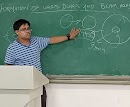Astronomy and Astrophysics
Types of Supernovae : A crisped analysis of one of the most energetic phenomenon of universe!!!
In my previous article I explained about the supernovae and their vital role in universe…….if you haven’t read it, then I recommend you to
read it first and then proceed to this article for better understanding!!!
Supernovae are classified on the basis of the shape of light
curves and the nature of their spectre.
What I have written in earlier article is just a part of the
story.
Not all of the supernovae are created by dying stars. Let’s
see the full story…..
Supernovae are categorised in two categories:- Type 1 and
Type 2. Type 1 is further divided into Type 1a, Type 1b and Type 1c.
The preliminary classification is based on the type of curves
on luminosity (solar units) vs Time (in days) graph. Type I if their light
curves exhibit sharp maxima and then die away gradually. The maxima may be
about 10 billion solar luminosities. Type 2 supernovae have less sharp peaks
at maxima and peak at about 1 billion solar luminosities. They die away more
sharply than the Type I.
Type 2 are not generally found in elliptical galaxies are
thought to be present in Population 1 type stars which are more likely to be
found in arms of spiral galaxies. Type 2 stars generally occurs in Population 2
type stars which are typically found in elliptical galaxies. Type Ia supernovae
occur in all kinds of galaxies, whereas Type 1b and Type 1c have been seen only
in spiral galaxies near sites of recent star formation (H II regions). This
suggests that Types Ib and Ic are associated with short-lived massive stars,
but Type 1a is significantly different.
But when astronomers studied and researched further in this
topic then, they felt a need of a more refined definition of the supernovae. To
get that refined definition, they looked in the spectra of each supernovae.
They are classified as Type I if they have no hydrogen lines in their spectra.
The subclass type Ia refers to those which have a strong silicon line at 615
nm. They are classified as Ib if they have strong helium lines, and Ic if they
do not. Type II supernovae have strong hydrogen lines.
How Type 1 and Type 2 supernovae are created???
It is believed that Type 1 supernovae are created by the
detonation of carbon white dwarfs when it collapses because of electron degeneracy. It is assumed that the white dwarf accretes enough mass to
exceed the Chandrasekhar
limit of 1.4 solar
masses for a white dwarf. The fact that the spectra of Type I supernovae are
hydrogen poor is consistent with this model, since the white dwarf has almost
no hydrogen. The smooth decay of the light is also consistent with this model
since most of the energy output would be from the radioactive decay of the
unstable heavy elements produced in the explosion.
Type 2 supernovae are believed to be caused by the explosion
of massive stars. This is the model which I explained in my previous article.
They show a characteristic plateau in their light curves a few months after
initiation. This plateau is reproduced by computer models which assume that the
energy comes from the expansion and cooling of the star's outer envelope as it
is blown away into space. This model is corroborated by the observation of
strong hydrogen and helium spectra for the Type II supernovae, in contrast to
the Type I.
 |
| Type 2 Supernova remnant |
How neutrinos are created during supernovae???
During supernovae, huge amount of neutrinos are created. Electrons
and protons fuse into neutrons, sending out huge numbers of neutrinos. The
outer layers will be opaque to neutrinos, so the neutrino shock wave will carry
matter with it in a cataclysmic explosion.
Now what are neutrinos???.....That’s the topic for another
article….and will be available soon in standard model section.
In upcoming articles, I am going to explain about Population 1 and 2 stars, Chandrashekhar limit, Electron and Neutron degeneracy and A
detail analysis of Type 1a supernovae…….Once they are uploaded the link will be
available here and also in my social handles.
To know more about bosons and fermions click here......
To know basics of quantum world, astronomy and space exploration you can check out my book "Through the wormhole" on amazon kindle.
You can directly talk with me on Instagram
To meet more physics Enthusiasts please join our Facebook Page
Also for latest updates of my posts join me on TwitterTo meet more physics Enthusiasts please join our Facebook Page
Thanks for reading.....
See you next time!!!
-Ratnadeep Das Choudhury
Founder and Writer of The Dynamic Frequency












0 Comments